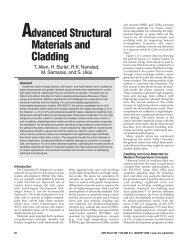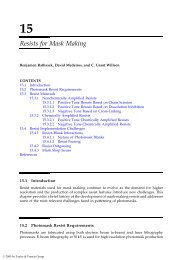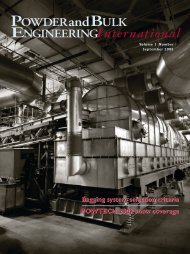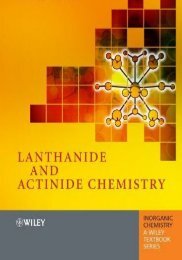Modeling of Biogas Reactors
Modeling of Biogas Reactors
Modeling of Biogas Reactors
You also want an ePaper? Increase the reach of your titles
YUMPU automatically turns print PDFs into web optimized ePapers that Google loves.
188 6 <strong>Modeling</strong> <strong>of</strong> <strong>Biogas</strong> <strong>Reactors</strong><br />
L is the length <strong>of</strong> the baffle and g is the gravitational acceleration. The gas holdup<br />
can be correlated from the superficial gas velocity u riser according to Weiland (1978).<br />
Due to experiments <strong>of</strong> Reinhold et al. (1996), it can be calculated according to Eqs.<br />
23 and 24).<br />
Äå = 0.27 u 0.8<br />
riser (laboratory scale) (23)<br />
Äå = 0.76 u 0.8<br />
riser (pilot scale) (24)<br />
The pressure loss coefficients were determined to be î = 6.9 on the laboratory<br />
scale and to be î = 4.8 on the pilot scale. As expected, the total friction coefficient î<br />
slightly decreases during scale-up.<br />
Figure 6.26 shows the exchange flow rate V · exchange as a function <strong>of</strong> the superficial<br />
gas velocity u exchange, which can be calculated according to Eq. 25.<br />
u exchange =<br />
V · gas<br />
A exchange<br />
It is quite remarkable that the findings <strong>of</strong> Figure 6.26 are invariant with the scale<br />
<strong>of</strong> the reactor. Because V · exchange dominates the mixing behavior <strong>of</strong> the system (indeed,<br />
it is the only experimental parameter necessary for model B) this result is very<br />
important for the scale-up <strong>of</strong> biogas tower reactors.<br />
6.4.2<br />
Distribution <strong>of</strong> Biomass within the Reactor<br />
The wastewater is passing the BTR from the bottom to the top <strong>of</strong> the reactor. With<br />
this feeding procedure the upflow velocity due to the feed increases – at a constant<br />
mean residence time <strong>of</strong> wastewater in the reactor – linearly with the height <strong>of</strong> the reactor.<br />
Therefore, in high reactors it is essential to have reliable mechanisms to retain<br />
the active biomass. These mechanisms and the resulting distribution <strong>of</strong> biomass<br />
within the reactor were studied by Reinhold and Märkl (1997).<br />
6.4.2.1 Experiments<br />
Experiments were performed with a two-modular laboratory tower reactor (height<br />
6.5 m) and in a pilot scale tower reactor (height 20 m) as shown in Figure 6.2 and described<br />
in Table 6.1. The laboratory tower reactor was filled with tap water and anaerobic<br />
pelletized sludge. The sludge was biologically, inactive, as no substrate was<br />
present in the tap water, i.e., it did not produce any fermentation gas. Air was injected<br />
at the bottom <strong>of</strong> the column instead <strong>of</strong> real biogas. As the reactor was built out <strong>of</strong><br />
transparent material, visual observations were possible in addition to measurements<br />
from samples. The following observations were made during these experiments:<br />
• The suspended solids concentration in the lower module is always higher than in<br />
the upper module.<br />
(25)






